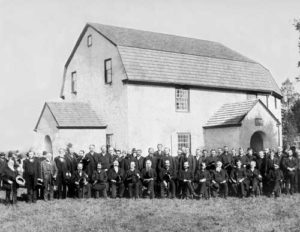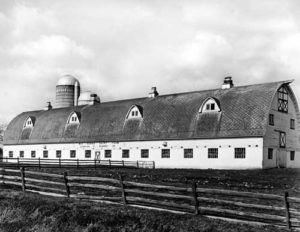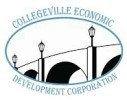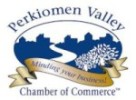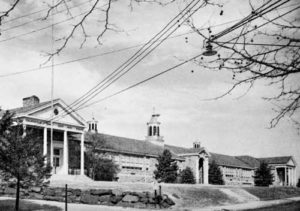724 W. Main Street
Located across from Augustus Lutheran Church, the Lamb Tavern was built about 1800. One of the first proprietors was Cornelius Tyson Sr. In 1836, the building was bought by schoolmaster and future U.S. congressman Jacob Fry Jr. (known as Honest Jacob) and described in the deed as a “certain Tavern stand, Sign of the Golden Lamb.” Private
Category: Uncategorized
Augustus Lutheran Church
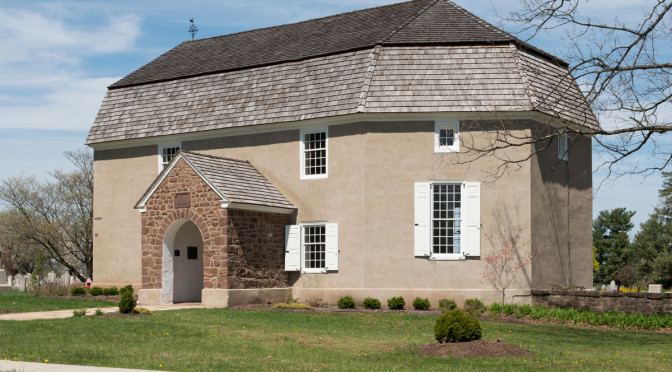
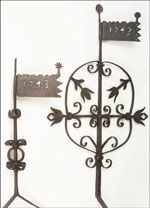
717 W. Main Street
Built between 1743 and 1745, Augustus Lutheran Church is known as the shrine of American Lutheranism. It was designated as a National Historic Landmark in 1967. Henry Melchior Muhlenberg served as its pastor from 1742 until his death in 1787. The wrought-iron weathervanes atop the roof are exact replicas of the originals. During the Revolutionary War, the church was used by the Continental Army as a field hospital. Many members of the Muhlenberg family and other prominent local residents, including Governor Francis Shunk, are buried in the graveyard. The parsonage was constructed in the late 1830s and the brick church in 1852. Tours are available by appointment. Open to the public
Augustus Lutheran Church, 1887. A severe windstorm on February 16, 1860, destroyed part of the church roof and spurred talk of demolition, but Rev. William Augustus Muhlenberg—an Episcopal minister and great-grandson of the founder—helped raise funds to restore the building. In October of 1887, the First District Conference of the Pennsylvania Ministerium was held at Augustus to commemorate the 100th anniversary of the death of Henry Melchior Muhlenberg (October 7, 1787). This photograph records that gathering. (Courtesy of Augustus Lutheran Church.)
Joseph Royer House
702 and 704 W. Main Street
The three-story stone house was built for Judge Joseph
Royer and his family in the early 1800s; the two-story wing
served as a general store and post office. Private
Trappe Hotel
595 W. Main Street
Built on land once owned by John Nicholas Cressman, a
German immigrant and early Trappe settler, the Trappe Hotel
was an active tavern, polling place, and stagecoach stop
during the 1800s. For many years it was run by Jacob
Heebner. Private
Washington Hall
550 W. Main Street
Built about 1854, this three-story brick building was the
second location of the Washington Hall Collegiate Institute
(est. 1830 as the Trappe Boarding School). Henry Prizer taught the original school (see 360 W. Main). Private
Brownback Store
538 W. Main Street
Born and educated in Trappe, E. G. Brownback married Mary
Beaver in 1895. He took over his father-in-law John Beaver’s
mercantile business and operated it in this building. Private
John Beaver House

532 W. Main Street
Home of John K. Beaver, a tailor by trade, who later established
the Beaver & Shellenberger mercantile firm, which
operated in Skippack and later Trappe. In 1895, the Trappe
store at 538 W. Main was taken over by Beaver’s son-in-law,
E. G. Brownback. Private
Trappe Borough Hall
 525 W. Main Street
525 W. Main Street
Built in 1922 as a school, this building now serves as the borough hall. Paintings of local historic sites by artist Julie Longacre are displayed in the council room. Behind the building is a tot-lot, picnic pavilion, and multipurpose play area. Open to the public
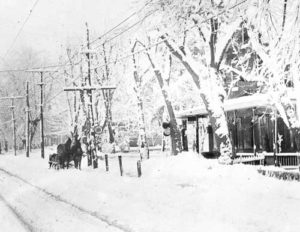
Abraham Treichler House
504 W. Main Street
Built for Abraham Treichler, a blacksmith, about 1852.
Private
Streeper-Gordon House
439 W. Main Street
Built in the mid-1800s, this brick house stands on a property
acquired by Widow Sarah Gordon in 1829. She was the
daughter of Bernard Streeper and Sarah Dewees; after her
death in 1839, the property passed to her son William
Gordon, a stonemason. Private
Thomas Davis House
438 W. Main Street
This two-story brick house was built about 1848 for Dr.
Thomas Davis, a prominent physician in Montgomery
County. It was the first house lot subdivided from the
Fountain Inn tract (now the Trappe Tavern). Later owners
include Dr. Charles Dickensheid and Mrs. Philip Bechtel. The
exterior of the house remains in nearly original condition
and is a fine example of mid-1800s architecture. Private
Trappe Tavern
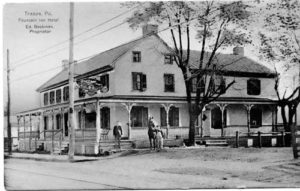
418 W. Main Street
Originally known as the Fountain Inn, this building has served
as a tavern since it was built in the late 1700s. A “Big Spring”
nearby provided water via underground wooden pipes to a
distillery and the inn, which had three fountain pumps in the
yard for watering thirsty horses. Traces of the spring remain
in the pond located at Rambo Park. By 1823, the inn’s barn,
sheds, and stables could accommodate up to 75 wagons and
150 horses. The Mingo Express Horse Company was founded
here in 1836 and continues to meet annually. Since 1989, the
tavern has served as a restaurant and bar. Open to the public
George Hagey House
417 W. Main Street
Built about 1830, this house was the residence of George
Hagey, a renowned clockmaker, from 1832 to 1844. A native
of nearby Lower Salford Township, George Hagey was the
second generation of his family to make clocks. Private
Henry Kratz House
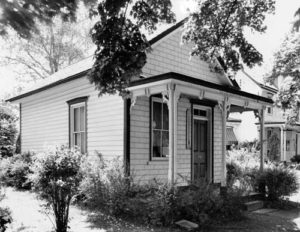
378 W. Main Street
Built for Henry Kratz in the mid-1800s, this house is flanked
by a smaller building to the east that once served as a post
office. Private
Henry Prizer House
360 W. Main Street
Built in the mid-1700s and used as a tavern known as the
Duke of Cumberland, this building was acquired in 1829 by
schoolmaster Henry Prizer, remodeled, and used as a school
prior to the construction of Washington Hall about 1854 (see
550 W. Main). A detached stone bake house stands behind
the main building. Private
John Fry House
314 W. Main Street
Several generations of the Fry family were carpenters and
cabinetmakers, beginning with Jacob Fry Sr. He was
succeeded in the trade by his son John, who built this house
about 1832 on the site of Jacob’s house. Private
Dewees Tavern
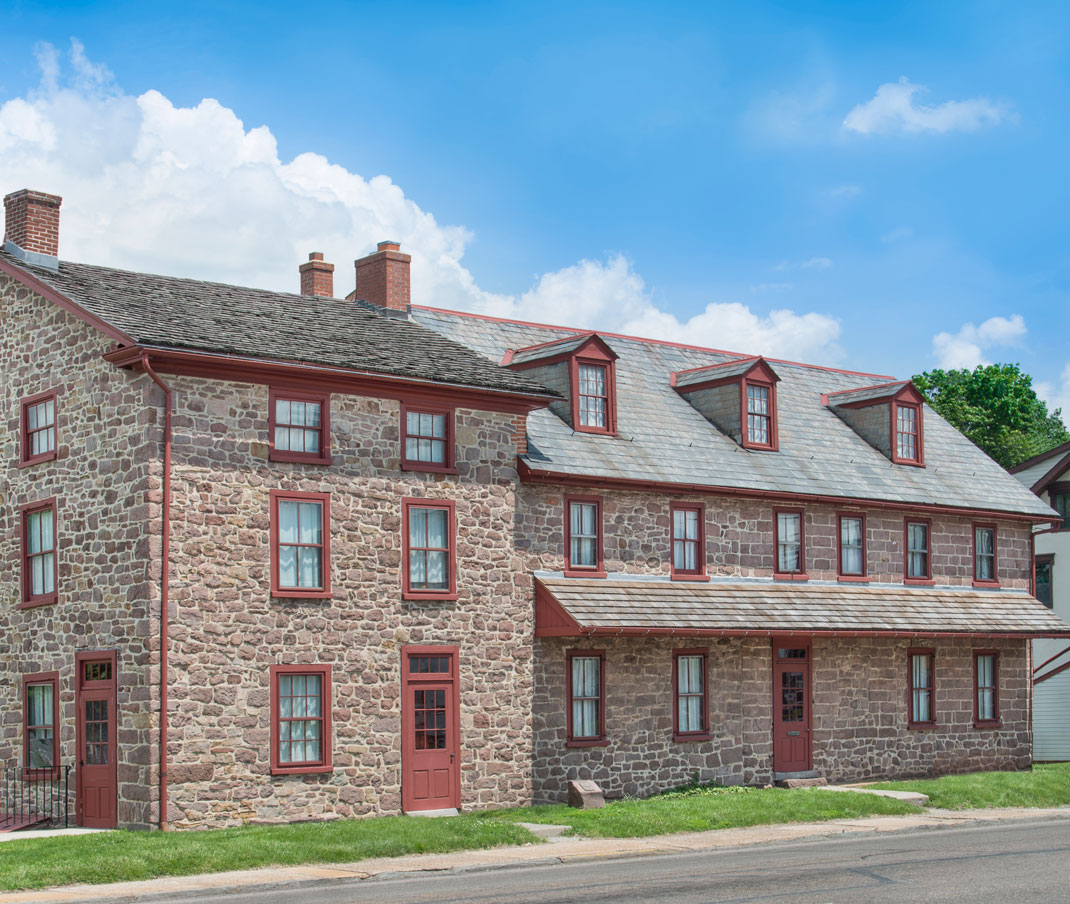
301 W. Main Street
Built in several sections from the mid-1700s to early 1800s, the east end of this building was the home of Andrew Miller, a joiner and bellows maker. In 1827 it was acquired by Dr. Jacob Dewees; his mother Mary Catharine Dewees ran it as a tavern and boarding house until 1855. The building also served as a polling place and stagecoach stop. It is now the headquarters of Historic Trappe, a museum, research library, and changing exhibitions. Open to the public
Enos Lewis House
224 W. Main Street
Built in the mid-1800s for Enos Lewis and his wife, Margaret
Dewees. Private
Daniel Fry House and Store
219 W. Main Street
Built in 1845 by Daniel Fry, this structure served as a general
store and dwelling house. The stone threshold for the store
entrance is inscribed “DRY GOODS.” Private
Philip Williard House
212 W. Main Street
This elegant two-story brick home was built in the
mid-1800s. During the 1870s, it was owned by Philip
Williard, a noted civic leader who was trained as a Reformed
Church minister. He married Anna Prizer, daughter of
Catharine Dewees and Henry Prizer (founder of Washington
Hall; see 550 W. Main). Private
St. Luke’s Church
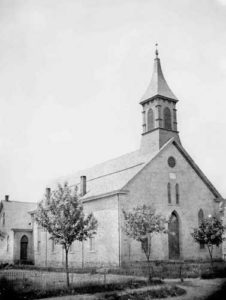
202 W. Main Street
Founded in 1742, St. Luke’s congregation initially worshipped
in a log church located across the street in the present-day
cemetery. A stone building replaced it on the same site in
1835. The present church was erected in 1874 under the
leadership of Rev. John H. A. Bomberger, founder of Ursinus
College and a Reformed Church minister. Open to the public
Henry Muhlenberg House

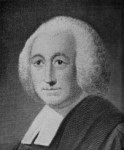
201 W. Main Street
Built about 1750 for Jacob Schrack Jr., a blacksmith, this large stone house was purchased by Henry and Anna Maria Muhlenberg in 1776. The Muhlenbergs added a rear wing, now missing, as a summer kitchen complete with a bake oven. Restored to its c. 1776 appearance and listed on the National Register of Historic Places.

Grange Hall
192 W. Main Street
Built in 1849 by the Providence Masonic Lodge, this building
was sold in 1865 to Warren Lodge. In 1913, it became the
headquarters of Keystone Grange #2, organized in 1873 and
the second oldest grange in Pennsylvania. Monthly meetings
are held on the third Wednesday at 7 p.m. Open to the public
The Speaker’s House
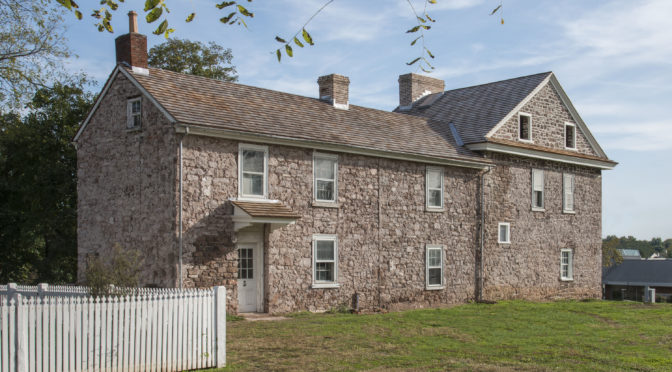
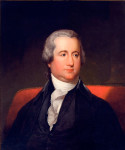
151 W. Main Street
Built in 1763 for John and Silence Schrack, this elegant stone house was owned by Frederick and Catharine Muhlenberg from 1781 to 1791. During this time, Frederick served as a member of the Continental Congress; Speaker of the Pennsylvania Assembly; first president judge, recorder of deeds, and register of wills for Montgomery County; and first Speaker of the U.S. House. From 1791 to 1803, the house was owned by Francis and Mary (Muhlenberg) Swaine; it later served as an Ursinus dormitory, from 1924 to 1944, known as Highland Hall. Tours of The Speaker’s House are available by appointment. Open to the public
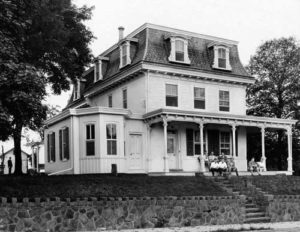
Toll Gate House
12 and 14 W. Main Street
Built in the early 1800s, this stone dwelling was the first toll
gate house in Trappe. Toll gates were permitted every five
miles along the Philadelphia and Reading Turnpike. In the
1820s, John Todd was the local toll gate keeper. Private
Wismer Barn
Wismer Barn, 1992. Construction began on the Wismers’ new barn in early 1932, with a plan based on a mid-Western design. Measuring 196 feet long and 38 feet deep, the new barn had stanchions for 100 cows, complete with automatic waterers, and could store up to 400 tons of hay in the upper level. With pointed arches rising 45 feet above the ground, the new barn was a technologically advanced agricultural superstructure. Like its predecessor, it too was lost in a fire, this time due to a spark from a hay mowing operation on June 10, 1997. The 150-head herd of cattle were moved twenty miles away to East Greenville while a new barn was built in just over three months. (Courtesy of Matthew G. Wismer.)
Fircroft
930 E. Main Street
Built about 1835 for Rev. Abraham Hunsicker, a Mennonite
bishop and the founder of Freeland Seminary, this dwelling
contains elements of an earlier stone house built for
Christian Schrack, son of Trappe’s founder and a tanner by
trade. Private
Andrew Todd House/Isenberg Hall
801 E. Main Street
Owned by Andrew Todd, who in 1832 donated land on which
a one-room stone schoolhouse—known as Todd’s school
School—was built (not extant) in place of an earlier log
schoolhouse. From 1844 to 1874, it was the Freeland Public
School. One of the oldest houses in Collegeville, this dwelling
was later owned by Dr. James Hamer. It is now known as
Isenberg Hall, after Rev. J.M.S. Isenberg, who graduated from
Ursinus in 1893 and was vice-president of the college until
1930. A nearby carved stone mile marker notes the distance
as 24 miles to Philadelphia and 28 miles to Reading. Private
Lynnewood Hall
702 E. Main Street
Former home of Ursinus professor Franklin I. Sheeder Jr.,
who served as registrar of the college from 1932 to 1946,
and his wife, Josephine Xander (both Ursinus graduates).
Lynnewood was acquired by the college in 1926 for women’s
housing. Private
Omwake Hall
701 E. Main Street
Acquired by Ursinus in 1964 and named after George Leslie
Omwake (class of 1898), president of the college from 1912
to 1936. Private
Schaff Hall
646 E. Main Street
This three-story brick house was built in the mid-1800s as a
private residence; it was acquired by Ursinus in 1967 and
named after Dr. Philip Schaff, a celebrated German Reformed
theologian and church historian in the 1800s. Private
Olevian Hall
640 E. Main Street
Acquired by Ursinus in 1967, this building was named after a
previous Olevian Hall that was razed to make way for the
construction of Pfahler Hall in 1931. Both were named after
Caspar Olevian, a German Reformed theologian. Private
Zwingli Hall
620 E. Main Street
Built during the mid-1800s as a private residence, Zwingli
Hall retains much of its original charm, including a large front
porch. It is named after Ulrich Zwingli, a Swiss theologian
and Reformation leader. Private
Duryea Hall
612 E. Main Street
Purchased in 1937 from A. D. Fetterolf by the Ursinus
Women’s Club, Duryea Hall was named ten years later in
honor of Rhea Duryea Johnson, who graduated from Ursinus
in 1908 and later became the college’s first female board
member. Private
Pfahler Hall
601 E. Main Street
Initially known as the Science Building, Pfahler Hall was
renamed in 1942 after Dr. George E. Pfahler, a pioneer in the
field of radiology. Here Dr. John W. Mauchly, professor of
physics from 1933 to 1941, began research that would lead
him to co-invent the ENIAC, the first electronic generalpurpose
computer. The observatory atop the building was
constructed in the 1950s, using scrap and war surplus
material, to house a telescope loaned by the Franklin
Institute. Private
Myrin Library
601 E. Main Street
Opened in 1971, Myrin Library houses more than 420,000
books and offers onsite and remote access to numerous
print, microform, and electronic periodical titles. It is also
home to the Ursinusiana collection, the Pennsylvania Folklife
Society archives, and many works of art made by Ursinus
students. Open to the public
Eger Gateway
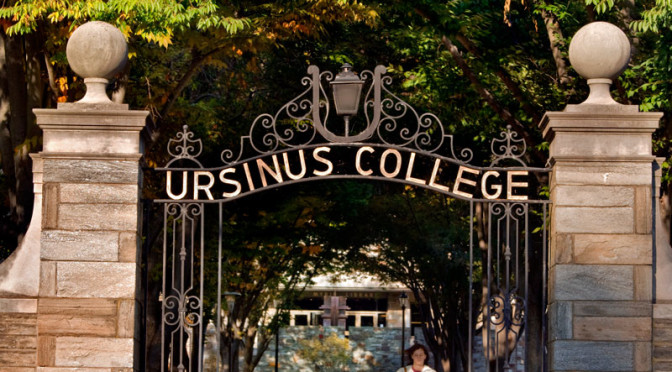
601 E. Main Street
Erected at the main entrance to Ursinus in 1925 through the
generosity of George P. Eger, this iron and stone gateway has
inset tablets telling the history of education on the campus
since 1832. Open to the public
Bomberger Hall
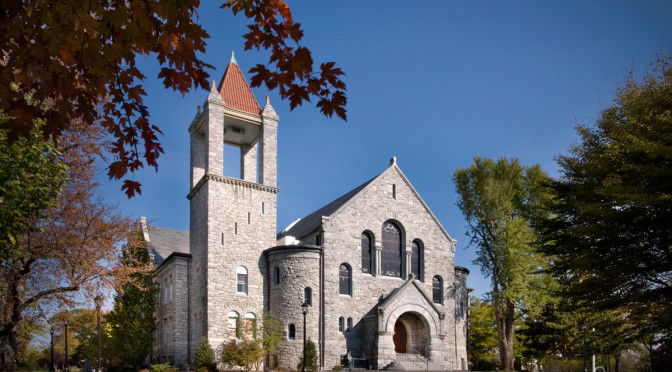
601 E. Main Street
Designed by architect Frank R. Watson of Philadelphia, the
cornerstone of Bomberger Memorial Hall was laid on June
25, 1891. Built in the Romanesque style, much of the stone
was quarried nearby in King of Prussia. Opened in 1892, the
building provided the college with modern classrooms,
offices, a library, and a chapel. The auditorium houses the
Heefner Memorial Organ, a three-manual 62-rank organ
dedicated in 1986. Open to the public for special events
Berman Museum of Art

601 E. Main Street
Opened in 1923 as the Alumni Memorial Library to
commemorate the 271 Ursinus students and alumni who
served in World War I, this elegant stone building is now
home to the Philip and Muriel Berman Museum of Art. The
museum hosts changing exhibitions and educational
programs throughout the year. Open to the public
Shreiner Hall
600 E. Main Street
Built in 1876 for Dr. John H. A. Bomberger, founder and first
president of Ursinus College, this structure was originally
known as Zwinglihof after the Swiss theologian and Reformation
leader Ulrich Zwingli. Dr. Bomberger lived here until his
death in 1890, after which it became Ursinus property. In
1909, it became a women’s dormitory. Private
Hobson Hall
568 E. Main Street
Built in the late 1800s as a private residence, Hobson
Hall’s three-story tower, asymmetrical façade, and
multiple porches exemplify the Queen Anne revival
style that was popular in America from about 1880 to
1910. It was acquired by Ursinus from Edward and
Mabel (Hobson) Fretz in 1944. Private
Fetterolf House
554 E. Main Street
This three-story stone farmhouse was built during the
1800s by William Tennent Todd, a spinning wheel
maker; it was the first residence of Rev. John H. A.
Bomberger, founding president of Ursinus College.
From 1867 to 1872, it was the home of Captain Henry
H. Fetterolf, who served in the Civil War. The house was
later donated to the college by Henry’s daughter,
Harriet “Hattie” Fetterolf. Private
Trinity Church
532 E. Main Street
Founded in 1854 and incorporated the following year, Trinity
Reformed U.C.C. has a long history of welcoming members of
the community for worship. The church played a prominent
role in the abolition movement, and 27 Civil War veterans are
buried in the cemetery. Every pastor to this day has been an
Ursinus graduate. Until Bomberger Hall was completed in
1892, Trinity hosted the college’s assemblies, commencement,
and religion classes. In 1922, an addition was built and
named after the church’s first pastor, Dr. Joseph Hendricks.
Known as the Hendricks Building, it houses community
gatherings and served as the town’s first movie theater.
Open to the public
Keigwin Hall
513 E. Main Street
Keigwin Hall was purchased by Ursinus in 1963 and named
after Rev. Albert Edwin Keigwin, who served as president of
the college from 1907 to 1912. Private
Maples Hall
512 E. Main Street
Acquired by Ursinus in 1923, Maples was first used as a
women’s dormitory. It was the birthplace and childhood
home of Dr. Calvin D. Yost Jr., who wrote the first history of
the college. Private
Glenwood Avenue
This monument marks the site of the Pennsylvania Female
College, founded in 1851 by J. Warren Sunderland as the
Montgomery Female Seminary and chartered by the state
legislature in 1853. A four-year liberal arts college, it closed
in 1880. During its 30-year tenure, more than 1,000 young
women were educated there. The seminary building once
stood at the end of Glenwood Avenue on a bluff overlooking
the Perkiomen Creek. Open to the public
Collegeville Borough Hall
Clamer Hall
409 E. Main Street
Built by Francis J. Clamer, a German immigrant and metallurgist,
in 1903, Clamer Hall was given to Ursinus by Dr. Guillam
H. Clamer in 1953. Private
Warren Lodge
324 E. Main Street
Warren Lodge #310 is home to the Collegeville-area Free and
Accepted Masons, founded in 1857. Meetings have been
held in this building since it was erected in 1913. Private
Perkiomen Bridge Hotel
1 E. Main Street
According to local tradition, the oldest portion of this
building was erected in 1701 for Edward Lane. By 1798, the
inn consisted of a two-story stone building measuring 33 x
25 feet and a one-story stone kitchen of 30 x 20 feet. It was
further expanded in the 1800s and became a fashionable
hotel and summer resort due to its location along the
Perkiomen Creek. Listed on the National Register of Historic
Places in 1985, until recently it was the oldest hotel in
continuous operation in the country. The nearby Perkiomen
Bridge was completed in 1799 and is one of the oldest stone
arch bridges still in use in the United States. Private
Perkiomen Bridge
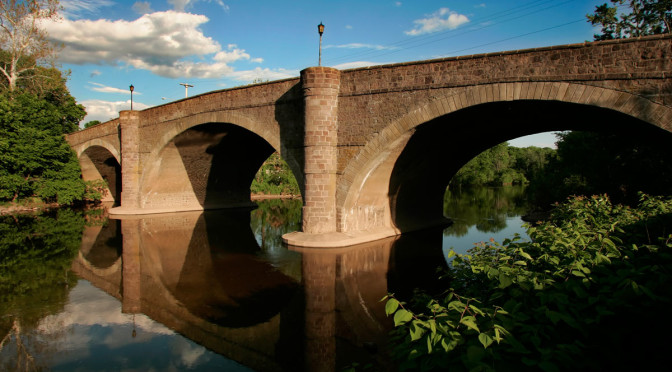
The Perkiomen Bridge was completed in 1799 and is one of the oldest stone arch bridges still in use in the United States.
Collegeville-Trappe High School
29 E. First Avenue. A groundbreaking ceremony was held on November 11, 1938, for a new Collegeville-Trappe High School to be built under the auspices of the federal government’s Public Works Administration. The above postcard depicts the school as built; in 1953 an addition was built on the right side to match the colonial revival style of the original building, as seen in the postcard below. Howard B. Keyser, a 1905 graduate of the Collegeville High School and 1910 Ursinus graduate, was the supervising principal of the newly consolidated school district. The project architect was W. Marshall Hughes of Reading, Pennsylvania, and the general contractor was Warren B. Zern of Pottstown, Pennsylvania. Most of the land for the new school was provided by Ursinus College in a bargain sale in which the former Frederick Muhlenberg property, at 151 W. Main Street, was subdivided. The former school is currently being converted into condominiums. (Courtesy of Jerry A. Chiccarine.)

